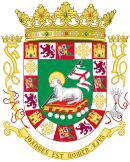
Back Constitució de Puerto Rico Catalan Constitución del Estado Libre Asociado de Puerto Rico Spanish
| Constitution of the Commonwealth of Puerto Rico | |
|---|---|
 Exhibition of the Constitution at the Capitol of Puerto Rico | |
| Original title | Constitución del Estado Libre Asociado de Puerto Rico |
| Ratified | July 25, 1952 |
| Location | Capitol of Puerto Rico, San Juan, Puerto Rico |
| Author(s) | 92 delegates from three parties |
| Purpose | Create a commonwealth in union with the United States |
| Full text | |
 |
|---|
The Constitution of the Commonwealth of Puerto Rico (Spanish: Constitución del Estado Libre Asociado de Puerto Rico, lit. 'Constitution of the Free Associated State of Puerto Rico') is the primary organizing law for the unincorporated U.S. territory of Puerto Rico, describing the duties, powers, structures and functions of the government of Puerto Rico in nine articles. It was ratified by the electorate of the archipelago and island in a referendum on March 3, 1952 and proclaimed into effect by Governor Luis Muñoz Marín on July 25, 1952, celebrated as Constitution Day. As the constitution of a territory of the United States, it is bound by the Constitution of the United States.
Under the constitution, the unincorporated U.S. territory of Puerto Rico is neither a sovereign country nor a state of the United States. Puerto Rico is subject to the territorial sovereignty and federal government of the United States, which is responsible for the monetary policy, foreign relations, defense, among enumerated powers. The local government of Puerto Rico is responsible for education, law enforcement, elections, among other reserved powers. Both governments share concurrent powers, including taxation and fiscal policy. The political status of Puerto Rico is an ongoing debate.